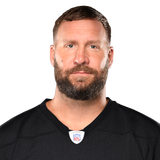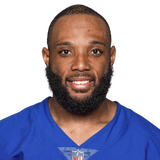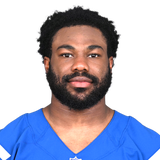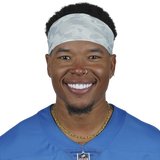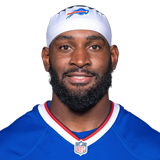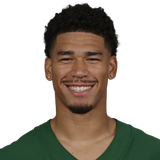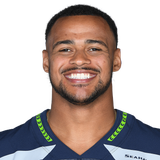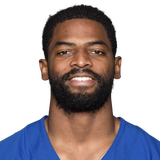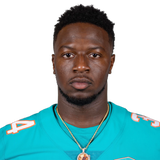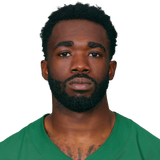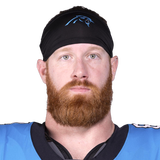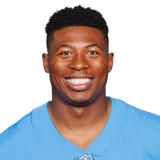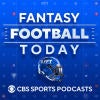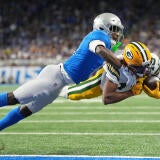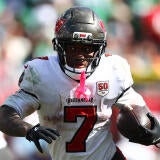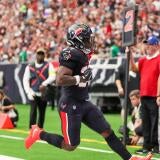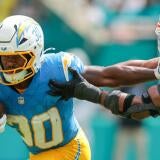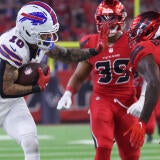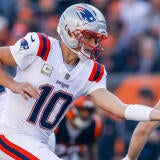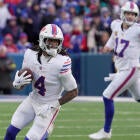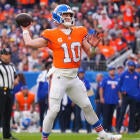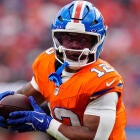2020 Fantasy Football Sleepers: Tyrod Taylor, Ben Roethlisberger, Matt Breida top expert picks
You'll spend weeks agonizing over your first-round pick, but it's the late-round sleepers who will determine if you bring home the trophy.

I never expected to be writing about Tyrod Taylor as a potential starting Fantasy option in 2020, but here we are. He could be a surprise starter in all leagues, which is why he's headlining Sleepers 2.0.
If we were guaranteed to get Taylor as the Chargers' starter for close to 16 games, I would have him ranked near or inside my top 12. He has that kind of upside. At the time of publication, I have him ranked at No. 19.
The talent on the Chargers' roster around Taylor is great with Keenan Allen, Mike Williams, Hunter Henry and Austin Ekeler. And the offensive line should be much improved with offseason additions of Trai Turner and Bryan Bulaga. The defense also should be excellent.
Taylor has proven he can run the ball with two seasons on his resume with at least 568 rushing yards and four rushing touchdowns when he was the starter in Buffalo. We love rushing yards for quarterbacks, and Taylor will hopefully still provide that, even at 31.
But, as we know, the Chargers have Justin Herbert waiting as their quarterback of the future after selecting him at No. 6 overall in the NFL Draft. And Herbert could start at any point in the season, which is why you're only drafting Taylor with a late-round flier in all Fantasy leagues.
However, should the Chargers and coach Anthony Lynn surprise us and stick with Taylor, he's going to be a popular waiver-wire addition this year in all formats. You might want to get ahead of that move and stash Taylor now if you have the roster space to carry two quarterbacks.
Sleepers
Sleepers
He only appeared in two games last season because of an elbow injury, which required season-ending surgery in September. But he seems to be ready to go in his comeback effort after posting a video of him working out in May. He's 38, and any significant injury at his age is difficult to recover from. The last time we saw Roethlisberger in a full season in 2018 he was the No. 3 Fantasy quarterback with 5,129 passing yards, 34 touchdowns and 16 interceptions, along with three rushing scores. Granted, that was when Antonio Brown was still a Steeler, but I'm excited for this receiving corps with JuJu Smith-Schuster and Diontae Johnson leading the way, as well as newcomers in Chase Claypool and Eric Ebron. Could Roethlisberger finish as a top three Fantasy quarterback again? Probably not. But a top-10 finish for a guy you're probably drafting in Round 10 or later is doable, and I'm buying plenty of stock in Roethlisberger this year.
| ||||||||||
Goff went from the No. 6 quarterback in 2018 to the No. 15 quarterback last year. So what changed? His offensive line regressed, and the Rams struggled to run the ball. He also had Brandin Cooks miss time due to injury, and all of those issues could be a concern again, especially with Todd Gurley and Cooks no longer on the roster. But if you take out four horrific games for Goff last season against top defenses in San Francisco, Pittsburgh, Chicago and Baltimore, where he combined for 12 Fantasy points, he wasn't awful the rest of the year. In those other 12 outings, Goff averaged 22.3 Fantasy points per game, including 23 points at San Francisco in Week 16. I'm hopeful for Cam Akers and potentially Darrell Henderson to be quality replacements for Gurley, but the Rams passing attack might have to carry this offense. Goff offers plenty of rebound potential at a reduced price after Round 10.
| ||||||||||
Other sleeper quarterbacks to consider: Baker Mayfield, Drew Lock, Joe Burrow
Breida escaped his personal purgatory this offseason when the 49ers traded him to the Dolphins for a fifth-round pick. What I mean by purgatory is that he was slated to be the third running back in San Francisco behind Raheem Mostert and Tevin Coleman, but in Miami, Breida should be the best running back. He'll compete with Jordan Howard for touches, but Breida should be the better Fantasy option, and he's worth drafting as early as Round 7 in all leagues. Breida didn't do much in 2019 with Mostert and Coleman doing most of the heavy lifting, but in 2018 he was San Francisco's best running back, and he scored at least 12 PPR points in seven of the 14 games he played. He tends to deal with injuries often, but he usually plays through them. And he's explosive when he's on the field, averaging 5.0 yards per carry in his career. He's never had more than 27 catches in a season, but that could happen this year. I like Breida as a No. 3 Fantasy running back on Draft Day, but he has top-20 upside in all formats.
| ||||||||||
At worst, Moss could play the Frank Gore role in Buffalo's offense this year, which would be the team leader in carries (166), carries inside the 10-yard line (18) and carries inside the 5-yard line (11). At best, he could be the best running back for the Bills and a starting Fantasy option. Moss will compete with Devin Singletary for touches, and Singletary showed flashes of greatness as a rookie. He also struggled to stay healthy and wasn't used as a goal-line option (three carries inside the 10-yard line and two inside the 5-yard line). Josh Allen will also be a factor on the ground, and he led the team with nine rushing touchdowns. But I expect the Bills to give Moss a shot to be the featured guy in their backfield, and he was a standout rusher at Utah over the past three seasons with 628 carries for 3,685 yards (5.9 yards per carry) and 36 touchdowns, as well as 65 catches for 681 yards and three touchdowns. Moss has the chance to be a No. 2 Fantasy running back in all leagues, and he's worth drafting as early as Round 8.
| ||||||||||
Hines is more of a PPR option given his role for the Colts, especially after the team added standout rookie Jonathan Taylor to go with Marlon Mack. But Hines is likely to see the most time on passing downs, which matters when it comes to playing with Philip Rivers. After Taylor was selected in the second round of the NFL Draft, I didn't alter my ranking of Hines, who can be used as a flex in PPR. I expect Rivers to lean on Hines a lot in the passing game, and Rivers has a lengthy track record of throwing to running backs. LaDainian Tomlinson, Darren Sproles, Mike Tolbert, Danny Woodhead, Melvin Gordon and Austin Ekeler each had at least one season with 75-plus targets playing alongside Rivers in the Chargers backfield. In 2019, Rivers connected with Gordon and Ekeler for 134 catches for 1,289 yards and nine touchdowns on 163 targets. In two seasons in the NFL, Hines has averaged 54 catches, 372 yards and one touchdown on 70 targets. This could be a tremendous marriage of Rivers and Hines in 2020.
| ||||||||||
I'm drafting Evans as a lottery ticket this year. I'm nervous about Derrick Henry coming off 400-plus touches in 2019, including the playoffs, and he could suffer an injury because of so much wear and tear. Evans is expected to be the handcuff to Henry this season, and that would obviously put him in a prominent role if he got the chance to start for the Titans if Henry suffered an injury. Tennessee finished 2019 as the third-best rushing team in the NFL, and it's doubtful the Titans would change their style dramatically even if Henry were out. Tennessee selected Evans in the third round of the NFL Draft out of Appalachian State. He's coming off consecutive seasons with at least 1,200 total yards, and he scored 23 total touchdowns in 2019. And according to 247Sports, over the past two seasons, no FBS running back had more 50-plus yard running plays than Evans with 11, including Clyde Edwards-Helaire, D'Andre Swift, J.K. Dobbins and Jonathan Taylor. Since 2018, Evans has recorded 34 total 20-plus yard plays as a runner and receiver. He's explosive, and he could be fun if given an expanded role. He's a good running back to stash on your bench.
| ||||||||||
Other sleeper running backs to consider: Alexander Mattison, J.K. Dobbins, A.J. Dillon, Ryquell Armstead, Antonio Gibson
Jones deserves more credit than he usually gets. He was a solid Fantasy option in 2019, especially when Matthew Stafford was healthy, but Jones missed the final three games of the season with an injured ankle. For the year, Jones had six games with at least 12 PPR points. And in the first eight games of the season with Stafford before his back injury, Jones had 42 catches for 535 yards and six touchdowns, which put him on pace for 84 catches, 1,070 yards and 12 scores. He's the No. 2 receiver in Detroit behind Kenny Golladay, and the Lions have plenty of mouths to feed when you add in T.J. Hockenson, Danny Amendola, Swift and Kerryon Johnson. But Jones has averaged at least 14.0 PPR points per game in two of the past three seasons, and he's an excellent No. 3 Fantasy receiver to target with a mid-round pick. He averages about 7.0 targets per game over the past three seasons, and the Lions should once again be a pass-happy team. I love the idea of stashing Jones on my bench and using him as a starter once he gets hot, which is bound to happen based on his track record in Detroit.
| ||||||||||
The Jets lost Robby Anderson as a free agent this offseason but added Breshad Perriman and Denzel Mims. While the latter has plenty of upside as a promising rookie, and Perriman proved he can be productive based on his final five games in Tampa Bay last year, I'm still expecting Crowder to be the No. 1 receiver for the Jets. He had a solid season in New York in 2019, and he plays the slot for Adam Gase, which has always been a good role (see Jarvis Landry in Miami). Last season, Crowder had seven games with at least 15 PPR points in the 13 games Sam Darnold played (he missed three games with mono). If you take the stats Crowder produced in the 13 games with Darnold and project that over 16 games, he would have finished with 86 catches for 932 yards and six touchdowns on 132 targets. We'll see how everything fits with the Jets with Mims and Perriman, and Chris Herndon is also back after being out all of last year, along with Le'Veon Bell. But I'm excited to draft Crowder as a No. 3 PPR receiver with a mid-round pick, and he could end up as a weekly starter since he should still be the go-to receiver for Darnold in 2020.
| ||||||||||
Miller is one of my favorite late-round targets in all leagues, and he should be a third-year breakout this season. He's trending in the right direction after his production over the first two years of his career. As a rookie in 2018, Miller had 33 catches, 423 yards and seven touchdowns on 54 targets. He followed that up with 52 catches, 656 yards and two touchdowns on 85 targets, and this should be his best year yet since he's locked into a featured role as the No. 2 receiver in Chicago behind Allen Robinson. Miller produced at a high level when Taylor Gabriel missed the final five games last year with a concussion, and Gabriel was released this offseason, with no significant replacement option brought in to compete for targets. With Gabriel out, Miller scored at least 13 PPR points in three of the final five outings of the season, including two games with at least 23 PPR points. Chicago also should get improved quarterback play from Nick Foles over Mitchell Trubisky, which is a plus for Miller and Robinson. You can draft Miller in Round 10 or later, but he should outperform his Average Draft Position by a wide margin if things go right.
| ||||||||||
Anyone who watched the NFL Draft noticed the Packers failed to address their receiving corps, leaving Davante Adams as the lead singer with a bunch of backup dancers. But maybe Lazard can escape from the shadows and creep into the spotlight, which might be what Green Bay is hoping for with their third-year receiver. He's worth drafting as a No. 3 Fantasy receiver with a mid- to late-round pick, and hopefully he takes advantage of this tremendous opportunity as a starter for Aaron Rodgers. Lazard got the chance for increased playing time starting in Week 6, and his role continued to grow over the season. He had five games with at least five targets, including the final two regular-season games with 17 combined, and he averaged 11.0 PPR points in those outings. While he might not become a superstar if Adams stays healthy, he should be a borderline starter or flex if things go right. And, following the NFL Draft, things are pointing up for Lazard this year.
| ||||||||||
Other sleeper wide receivers to consider: Jalen Reagor, Sterling Shepard, Laviska Shenault, Justin Jefferson, Preston Williams
I originally had Fant pegged as a breakout candidate this season before the NFL Draft, but after the Broncos selected Jerry Jeudy and K.J. Hamler to go with Courtland Sutton, it appears like the ceiling for Fant could be somewhat capped. That said, I still plan to draft Fant as a low-end starter in all leagues with a late-round pick. He profiles as a tight end with star potential, and we saw Fant flash some big performances as a rookie in 2019 with three games with at least 11 PPR points. He's capable of more, and he should develop solid rapport with Drew Lock. Hopefully, the talented receiving corps around him will open up passing lanes, and he could prove to be Denver's best pass catcher. During Super Bowl week in Miami, Broncos star edge rusher Von Miller joined us on CBS Sports HQ on Radio Row, and he named Fant as a breakout candidate for Denver this year. Maybe that's the category he belongs in, but for now I'm going with Fant as a sleeper tight end for 2020. He has top-10 upside this season.
| ||||||||||
Line Hines, Doyle should benefit with Rivers joining the Colts. Rivers has a great history of throwing to his tight ends, including future Hall of Famer Antonio Gates and standout Hunter Henry during his time with the Chargers. Doyle isn't on their level as a playmaker, but he did have a productive season in 2017 with 11.3 PPR points per game on 80 catches, 690 yards and four touchdowns on 108 targets. That's a realistic expectation this season for Doyle, who should be among the top four pass catchers for the Colts with T.Y. Hilton, Michael Pittman Jr. and Hines. Doyle is a good tight end to wait for on Draft Day, and he should be considered a low-end starter in most leagues.
| ||||||||||
Other sleeper tight ends to consider: Ian Thomas, Chris Herndon, Jace Sternberger
More Sleepers from the Fantasy Football Today crew
There's been an impactful rookie Fantasy quarterback every season since 2015. Burrow profiles better than all of them. He's accurate, fearless, poised beyond his years and surrounded by a good receiving corps. Draft him late with another late-round quarterback (Matthew Stafford? Carson Wentz?) and reap the rewards.
| ||||||||||
Fantasy managers have to hope Slayton builds on the flashes we saw from him in 2019. He led the Giants in touchdown catches, yards per catch and yards per target (he missed yards per route run by 0.01 yards). Jason Garrett has some pass-happy tendencies and Slayton is their most explosive receiver.
| ||||||||||
The Dolphins rebuilt their offensive line, added an exciting quarterback and should be generally more competitive than in 2019. Breida represents the team's most explosive talent at running back and has underrated receiving potential. Land on him when you're looking for mid-round running back values.
| ||||||||||
Once again, Howard is slated to be a starting running back in Week 1 and Fantasy managers are avoiding him like he just ate the last of the five-alarm chili. Howard will share with Breida, and he won't catch a ton of passes, but he'll also be a fine flex and a borderline No. 2 for as long as he's healthy.
| ||||||||||
Mims has a shot to be the No. 1 receiver in New York by midseason, maybe sooner if Jamison Crowder can't stay healthy. He should eventually be the Jets' No. 1 red-zone threat and best downfield receiver and he'll be available in the double-digit rounds of most drafts.
| ||||||||||
Hurst takes over for Austin Hooper and has a chance to be every bit as productive. He's a former first-round pick who has been very efficient in limited action. Dirk Koetter's offenses have averaged more than 120 targets to tight ends over the past three seasons.
| ||||||||||
Stafford's 10.6-yard average throw depth was highest in the league and in stark contrast to his recent history; he'd averaged 8.0 or shallower each year since 2013. The vertical passing brought back his early-career Fantasy upside, and while he's due for some per-attempt regression, he goes much later than his QB3 points-per-game rank from 2019. His top weapons remain the same and Darrell Bevell returns for his second year as offensive coordinator, so Stafford should be able to build on his 2019 success.
| ||||||||||
There seems to be too much certainty in the size of Austin Ekeler's role given the ADPs of Kelley and Justin Jackson. Some of that is the uncertainty about who will be Ekeler's No. 2, but Jackson hardly got on the field in 2019 after his impressive end to 2018, and he's a former seventh-round pick. The team just took Kelley in the fourth round this offseason, and his solid prospect profile makes him a great late-round option who could have both standalone and handcuff value.
| ||||||||||
Hardman's 13.1 yards per target as a rookie isn't sustainable, but it speaks to how explosive he was in a limited role last season. Hardman typically didn't eclipse 50% snap shares unless Tyreek Hill left early or was inactive, and Sammy Watkins and Demarcus Robinson both returned this offseason. But playing time appears to be the only issue — Patrick Mahomes, the Chiefs offense as a whole, and Hardman's rookie production all speak to big upside if he sees the field with regularity. It might take an injury, or it might just be in the cards for Hardman in year two. He's worth the bench spot to find out.
| ||||||||||
So what Fantasy football sleepers should you snatch in your draft? And which WR1 candidate can you wait on until late? Visit SportsLine now to get Fantasy Football cheat sheets from the model that was all over Derrick Henry's huge season, and find out.


